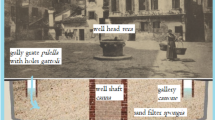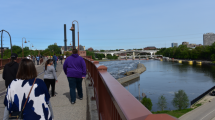Abstract
Aqueduct construction remains an important yet understudied chapter in the history of early modern European technology and urbanism. Combining the symbolism of form with the utility of function, aqueducts spoke the revived language of classical architecture, serving as monumental statements of princely beneficence, civic pride, and local identity. Mobilizing community resources in an act of political will, such projects marked the consolidating power of central authorities that spearheaded urban renewal through the creation and display of the improved water supply. The case of early modern Portugal is crucial for broadening the scope of this discussion, which is usually focused on sixteenth century Italy, situating it within a larger geographical and chronological context. While revealing the deep rootedness of Portuguese aqueducts in the local traditions of construction and water management, their analysis sheds new light on the central question of continuity and rupture in the transfer of hydraulic technology and knowledge from antiquity through the Middle Ages.
Access this chapter
Tax calculation will be finalised at checkout
Purchases are for personal use only
Similar content being viewed by others
Notes
- 1.
This work—which, in the case of Pisa, involved bringing water to the Palazzo Medici, the Piazza Cairoli, and the Piazza San Nicola—was carried out by the Medici engineer David Fortini; ASF, MP, 219, fol. 136v (Cosimo I to David Fortini 23 June 1563). For Cosimo’s hydraulic projects in Florence, see Tchikine (2014), Ferretti (2016).
- 2.
See documents transcribed in Pedone (1986), documents section, unpaginated.
- 3.
ASF, MP, 5120, fol. 118r (Ferdinando de’ Medici to Francesco I, 22 July 1586): “che potessi cavar’ la sete alla sua vigna.”
- 4.
- 5.
ASF, MP, 5120, fol. 118r (Ferdinando de’ Medici to Francesco I, 22 July 1586).
- 6.
ASF, CPG, neri, 797 (1629), supplica 292 (Ufficiali dei Fiumi to Cosimo II, 31 August 1612): “I condotti di questa fonte sono fatti con magnificenza, e senza risparmio di spesa, perché sono murati con molta maestria, e con la sua volticiuola sopra…”.
- 7.
See documents transcribed in Pedone (1986), documents section, unpaginated.
- 8.
Roman aqueducts existed in a number of Portuguese cities, including Lisbon, Beja, Évora, and Faro; the best preserved example is in Conimbriga (Caetano 1991, 15).
- 9.
Cf. the analogous situation in Elvas, where the initial work on the Aqueduto da Amoreira was also funded by a special levy on meat and fish. This tax had to be reintroduced in the early seventeenth century to continue the aqueduct’s construction (Mascarenhas and Carvalho Quintela, 2008, 92, 93–94).
- 10.
- 11.
My discussion of the Água de Prata is indebted to the recent work by Francisco Bilou.
- 12.
- 13.
- 14.
- 15.
- 16.
- 17.
On August 26, 1557, for example, Dowager Queen Catarina of Austria (1507–78), acting as regent during the minority of King Sebastião, conceded runoff of the Chafariz das Portas de Moura (1556) in Évora to Teodósio (1510–63), Duke of Braganza, for the irrigation of his orchards (Espanca, 1944, 22).
- 18.
For water sellers in Coimbra, still active through the late nineteenth century, see Veloso, 2012, 175.
- 19.
The need for this walkway, however, is not entirely clear, since service passages in the part of an aqueduct elevated above ground were not common in Portugal. Compared to the adjacent open channel, it has a flat, rather than rounded, bottom, is positioned at a lower level, and, instead of sidewalls of equal height, is flanked by a low parapet. Adding a secondary conduit to increase the capacity of the aqueduct would have involved widening the whole structure, unless the new watercourse could be placed above the original one (as in the Aqueduto da Amoreira in Elvas). Such massive rebuilding was clearly not the case at Tomar, suggesting that the passage in question was part of the original design and that its function was different. A likely reason for its inclusion concerns the substantial financial resources commanded by the monastery, which could afford this additional expense.
Bibliography
Manuscript Sources
Florence, Archivio di Stato, Mediceo del Principato (ASF, MP), 219.
Florence, Archivio di Stato, Mediceo del Principato (ASF, MP), 5120.
Florence, Archivio di Stato, Capitani di Parte Guelfa, numeri neri (ASF, CPG, neri), 797.
Printed Sources
Fontana, C. 1696. Utilissimo trattato dell’acque correnti… Rome: Buagni.
Holanda, F. de 1929. “Da fábrica que falece à cidade de Lisboa por Francisco de Olanda (1571).” Archivo español de arte y arquelogía, vol. 15 (4): 209–224.
Murphy, J. 1795. Travels in Portugal… London: Strahan et al.
Vasari, G. 1568. Vite de’ più eccellenti pittori, scultori e architettori. Florence: Giunta.
Secondary Literature
Antunes, T. M. 2012. “O Aqueduto do Convento de Cristo, em Tomar. Análise preliminar da estrutura hidráulica.” Revista Portuguesa de História, vol. 43: 265–289.
Belgrand, E. 1873–87. Les travaux souterrains de Paris, 5 vols. Paris: Dunod.
Bilou, F. 2010. A refundação do Aqueduto da Água da Prata, em Évora (1533–1537). Lisbon: Edições Colibri.
Caetano, J. O. 1991. Aquedutos em Portugal. Lisbon: Liber.
Conde, A. & Magalhães, O. 2008. “Abordagem educativa de um monumento: o aqueduto de Évora.” In: García, A. E. M. & Núñez, E. M. (eds.), El patrimonio cultural: tradiciones, educación y turismo. Cáceres: Imprenta Provincial de Cáceres.
Criado, M. I. P. 1987. “El Acueducto de los Pilares de Oviedo.” Liño: Revista anual de historia del arte, vol. 7: 39–54.
Cunha Saraiva, J. da 1938. O Aqueduto das Águas Livres e o arquitecto Ludovice. Lisbon: s. n.
Delgado, D. C. 2017. Preservar los puentes. Historia de la conservación patrimonial de la ingeniería civil en España (siglo XVI–1936). Madrid: Fundación Juanelo Turriano.
Espanca, T. 1944. Cadernos de história e arte eborense. O Aqueduto da Água da Prata. Évora: Nazareth.
Evans, H. B. 2002. Aqueduct hunting in the seventeenth century: Raffaello Fabretti’s De aquis et aquaeductibus veteris Romae. Ann Arbor: University of Michigan Press.
Ferretti, E. 2016. Acquedotti e fontane del Rinascimento in Toscana: acqua, architettura e città al tempo di Cosimo I dei Medici. Florence: Olschki.
Olvera García, J. & Ocaña Ponce, J. A. (eds.) 2016. Acueducto del Padre Tembleque: patrimonio de la humanidad. Toluca: Universidad Autónoma del Estado de México.
Llaguno y Amirola, E. 1829. Noticias de los arquitectos y arquitectura de España desde su restauración, 4 vols. Madrid: Imprenta Real.
Long, P. O. 2010. “Water supply.” In: A. Grafton, G. W. Most, & S. Settis (eds.), The classical tradition. Cambridge, MA, and London: Belknap Press, 981–982.
Lowry, H. W. 2008. The sha** of the Ottoman Balkans, 1350–1500: the conquest, settlement & infrastructural development of northern Greece. Istanbul: Bahçeşehir University Publications.
Magnusson, R. J. 2001. Water technology in the Middle Ages: cities, monasteries, and waterworks after the Roman Empire. Baltimore and London: Johns Hopkins University Press.
Marcuello, J. F. 1987. “El túnel o ‘mina’ de Daroca: obra hidráulica del siglo XVI.” Revista de obras públicas, vol. 3257: 253–261.
Mascarenhas, J. M. de & Carvalho Quintela, A. de 2008. “O Aqueduto da Amoreira e o sistema de abastecimento de água a Elvas.” Monumentos, vol. 28: 92–101.
Mascarenhas, J. M. de et al. 2012. “O aqueduto romano de Olisipo: viabilidade ou utopia? Ensaio de traçado apoiado em modelação geográfica.” Revista Portuguesa de História, vol. 43: 239–264.
Mascarenhas, J. M. de et al. 2013. “The Aqueduct of Setúbal (Portugal). Characterization and development as heritage.” In: Wiplinger, G. (ed.), Historische wasserleitungen: gestern, heute, morgen. Internationales Symposium mit besonderer Berücksichtigung ihrer denkmalgerechten und betriebssicheren Erhaltung. Leuven: Peeters, 195–203.
Pedone, S. 1986. La Fontana Pretoria a Palermo. Palermo: Giada.
Rinne, K. W. 2010. The waters of Rome: aqueducts, fountains, and the birth of the baroque city. New Haven and London: Yale University Press.
Sebastian, S. 1962. “El arquitecto frances Quinto Pierres Vedel.” Archivo Español de Arte, vol. 35: 289–301.
Senos, N. 2018. “An appropriate past for Renaissance Portugal: André de Resende and the city of Évora.” In: K. Enenkel & K. Ottenheym (eds.), The quest for an appropriate past in literature, art and architecture. Leiden and Boston: Brill, 127–150.
Sousa Viterbo, F. de 1899–1922. Diccionario historico e documental dos architectos, engenheiros e constructores portuguezes ou a serviço de Portugal, 3 vols. Lisbon: Imprensa Nacional.
Spann, P. O. 1981. “Lagobriga expunged: Renaissance forgeries and the Sertorian War.” Transactions of the American Philological Association, 111 (1981), 229–235.
Squatriti, P. 1998. Water and society in early medieval Italy, AD 400–1000. Cambridge: Cambridge University Press.
Tchikine, A. 2014. “L’anima del giardino: water, gardens, and hydraulics in sixteenth-century Florence and Naples.” In: M. G. Lee & K. I. Helphand (eds.), Technology and the garden. Washington, DC: Dumbarton Oaks, 129–153.
Trindade, L. 2014. “A água nas cidades portuguesas entre os séculos XIV e XVI: a mudança de paradigma.” In: M. del Mar, L. Bartolozzi & V. Méndez Hernán (eds.), Patrimonio cultural vinculado con el agua: paisaje, urbanismo, arte, ingenieria y turismo. Mérida: Editora Regional de Extremadura, 367–380.
Tuttle, R. J. 2018. “Il sistema delle acque a Bologna nel Rinascimento.” In: E. Ferretti and F. Ceccarelli (eds.), Il Nettuno architetto delle acque: Bologna. L’acqua per la città tra Medioevo e Rinascimento. Bologna: Bononia University Press, 41–50.
Valdés, O. 1946. “Fray Francisco de Tembleque.” The Americas, vol. 3 (2): 223–233.
Veloso, M. T. N. 2012. “A água na cidade de Coimbra durante a Idade Média.” Revista Portuguesa de História, vol. 43: 159–181.
Acknowledgements
I would like to thank Ana Rodrigues for inviting me to contribute a chapter to this volume and for providing me, with the help of Magdalena Merlos Romero, with source materials in the course of its preparation. My additional thanks go to John Pinto for sharing with me his knowledge of the Vitruvian chorobates and to Jan Ziolkowski for his help translating the Latin motto on the medal of Cosimo I.
Author information
Authors and Affiliations
Corresponding author
Editor information
Editors and Affiliations
Rights and permissions
Copyright information
© 2020 Springer Nature Switzerland AG
About this chapter
Cite this chapter
Tchikine, A. (2020). Technology of Grandeur: Early Modern Aqueducts in Portugal. In: Duarte Rodrigues, A., Toribio Marín, C. (eds) The History of Water Management in the Iberian Peninsula. Trends in the History of Science. Birkhäuser, Cham. https://doi.org/10.1007/978-3-030-34061-2_7
Download citation
DOI: https://doi.org/10.1007/978-3-030-34061-2_7
Published:
Publisher Name: Birkhäuser, Cham
Print ISBN: 978-3-030-34060-5
Online ISBN: 978-3-030-34061-2
eBook Packages: Mathematics and StatisticsMathematics and Statistics (R0)




